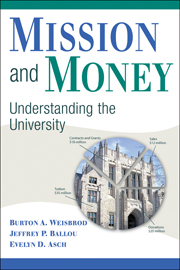Book contents
- Frontmatter
- Contents
- Illustrations
- Preface
- 1 An Introduction to the Higher Education Industry
- 2 The Higher Education Business and the Business of Higher Education – Now and Then
- 3 Is Higher Education Becoming Increasingly Competitive?
- 4 The Two-Good Framework: Revenue, Mission, and Why Colleges Do What They Do
- 5 Tuition, Price Discrimination, and Financial Aid
- 6 The Place of Donations in Funding the Higher Education Industry
- 7 Endowments and Their Management: Financing the Mission
- 8 Generating Revenue from Research and Patents
- 9 Other Ways to Generate Revenue – Wherever It May Be Found: Lobbying, the World Market, and Distance Education
- 10 Advertising, Branding, and Reputation
- 11 Are Public and Nonprofit Schools “Businesslike”? Cost-Consciousness and the Choice between Higher Cost and Lower Cost Faculty
- 12 Not Quite an Ivory Tower: Schools Compete by Collaborating
- 13 Intercollegiate Athletics: Money or Mission?
- 14 Mission or Money: What Do Colleges and Universities Want from Their Athletic Coaches and Presidents?
- 15 Concluding Remarks: What Are the Public Policy Issues?
- Appendix
- References
- Index
9 - Other Ways to Generate Revenue – Wherever It May Be Found: Lobbying, the World Market, and Distance Education
Published online by Cambridge University Press: 17 July 2009
- Frontmatter
- Contents
- Illustrations
- Preface
- 1 An Introduction to the Higher Education Industry
- 2 The Higher Education Business and the Business of Higher Education – Now and Then
- 3 Is Higher Education Becoming Increasingly Competitive?
- 4 The Two-Good Framework: Revenue, Mission, and Why Colleges Do What They Do
- 5 Tuition, Price Discrimination, and Financial Aid
- 6 The Place of Donations in Funding the Higher Education Industry
- 7 Endowments and Their Management: Financing the Mission
- 8 Generating Revenue from Research and Patents
- 9 Other Ways to Generate Revenue – Wherever It May Be Found: Lobbying, the World Market, and Distance Education
- 10 Advertising, Branding, and Reputation
- 11 Are Public and Nonprofit Schools “Businesslike”? Cost-Consciousness and the Choice between Higher Cost and Lower Cost Faculty
- 12 Not Quite an Ivory Tower: Schools Compete by Collaborating
- 13 Intercollegiate Athletics: Money or Mission?
- 14 Mission or Money: What Do Colleges and Universities Want from Their Athletic Coaches and Presidents?
- 15 Concluding Remarks: What Are the Public Policy Issues?
- Appendix
- References
- Index
Summary
The choice of the mission and the manner in which it is financed are inextricably linked for any college or university. Research, teaching, and outreach lead schools to invest in specific means to raise revenue to support their missions. Lobbying, international expansion, and distance education are excellent examples of distinct ways of financing schools' particular missions.
LOBBYING: SPENDING MONEY TO MAKE MONEY
Lobbying legislatures for funding or legislation has a long (if sometimes unsavory) history in the United States. Colleges and universities have increasingly included lobbying among their methods of revenue pursuit, just as organizations in other industries have. Public, nonprofit, and for-profit schools are spending money on in-house lobbyists or on lobbyists from outside firms. Influencing Congress to enact favorable legislation can advance a research university's efforts or lead to regulatory changes desired by for-profit schools. We find some intriguing patterns of lobbying activity in higher education.
The search for revenue led three universities to spend close to $1 million each on lobbying in 2004 – $930,000 by Boston University, $937,000 by the University of Miami, and $940,000 by Johns Hopkins University (Center for Responsive Politics 2007), and over the next three years a number of schools reported annual lobbying expenditures over $700,000 – including Harvard and Northwestern as well as Johns Hopkins and Boston Universities. These sums are tiny in the overall budgets of these schools where research expenditures alone, in 2005, were $337 million at Boston, $287 million at Miami, and $1.7 billion at Johns Hopkins (AUTM 2005).
- Type
- Chapter
- Information
- Mission and MoneyUnderstanding the University, pp. 162 - 174Publisher: Cambridge University PressPrint publication year: 2008

